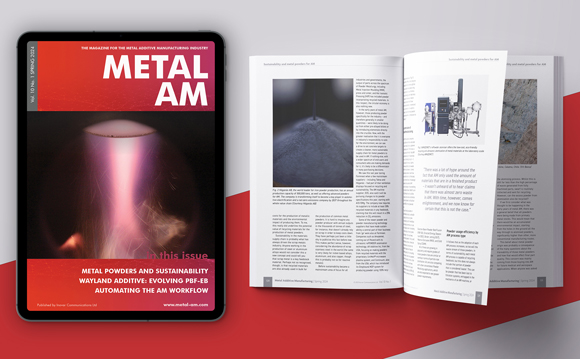Fraunhofer ILT, MTU Aero Engines, Airbus and Mercedes-Benz collaborate on hybrid AM
April 27, 2020
The Fraunhofer Institute for Laser Technology (ILT), Aachen, Germany, is collaborating with MTU Aero Engines, Airbus and Mercedes-Benz on the ProLMD research project. Established in 2016 and funded by the German Federal Ministry for Education and Research (BMBF), the project’s aim is to develop new hybrid processes that combine conventional production methods with Laser Material Deposition (LMD) to develop a new manufacturing approach.
Fraunhofer ILT, together with a total of seven industrial partners, will collaborate on the development of a highly efficient, modular LMD cell that can be integrated into an existing process chain with little effort. To take advantage of maximum application flexibility, the partners are developing processes using both wire and powder materials.
Additionally, Fraunhofer ILT has developed a processing optic for generating a ring beam for coaxial laser material deposition, which is being further developed and used in the joint ProLMD project. This optic generates a ring with a uniform intensity distribution, thus offering directional independence during welding. In the project, processes with deposition rates in the range of 1 to 2 kg/h at high geometric resolution are being developed.
“The aim was to develop economical and robust system technology for the LMD process, based on a jointed-arm robot, and to integrate it into a process chain for hybrid manufacturing,” stated Jan Bremer, a scientist at Fraunhofer ILT. “We are moving along the process chain for robot-based hybrid Additive Manufacturing and researching various technologies required for this. The spectrum of content covers everything – from processing heads, robot and shielding gas systems to welding processes, quality assurance and software.”
Fraunhofer ILT explained that what hybrid actually means in practice can be demonstrated by three applications from the project partners – MTU Aero Engines (the addition of functional elements on an engine component), Airbus (component reinforcement by the addition of AM ribbing) and Mercedes-Benz (the adaptation of a press tool in body production). The project focuses on locally reinforcing or modifying conventionally manufactured components, but the technologies developed also make repair applications possible.
Bremer added, “These examples show what we understand by hybrid manufacturing. It is the flexible combination of advantages from different manufacturing processes, as it combines any conventional manufacturing process with LMD to form a continuous process chain.”
Hybrid manufacturing also provides a good example of how complex variant diversity can be simplified in production, Bremer explained: “For example, you always start by punching and trimming a basic part in the same way. The variants are then later produced using LMD. The user can, therefore, continue to use his punching machine, but then additively apply reinforcements to the component, for example.”
“Thanks to the LMD process and the technologies developed in ProLMD, we can act flexibly and use automation to a great extent. This is in line with our guiding principle: Additive Manufacturing – but only in those parts of the process chain where it results in added value,” he concluded.
The division of tasks among the other project partners sees the Lasertec business unit of the KUKA site in Würselen responsible for project management and cell integration of the robot, while Laserline GmbH from Mülheim-Kärlich is in charge of the design and development of the beam source and optics. M. Braun Inertgas-Systeme GmbH, Garching, is responsible for the construction of a shielding gas cell, while Dortmund-based BCT Steuerungs- und DV-Systeme GmbH is developing the software and machine-integrated measuring technology.
While KUKA has its robot weld materials sensitive to oxidation, such as titanium, in a flexible shielding gas cell reliably, the Aachen-based engineers are using another robot system to weld nickel- and iron-based materials without a shielding gas cell, but with shielding gas flowing locally from the nozzle. If the deposition rate is higher, an additional shielding gas nozzle of a few centimetres in size is used as required.
Fraunhofer ILT states that, at its Aachen base, there is one large and one more compact robotic cell for Additive Manufacturing. With additional financial support from the BMBF, they are creating a less expensive version of the ProLMD robot system for small- and medium-sized enterprises (SMEs).
“We have scaled down the solution from a 3.1 m long robot arm with 90 kg load capacity to about 2 m and 60 kg load capacity,” Bremer further added. “On the large robot, we can demonstrate a flexible changing system with wire- and powder-based processing heads, while the small cell is all about powder-based LMD, machine-integrated geometry measurement and the new CAM module.”
















